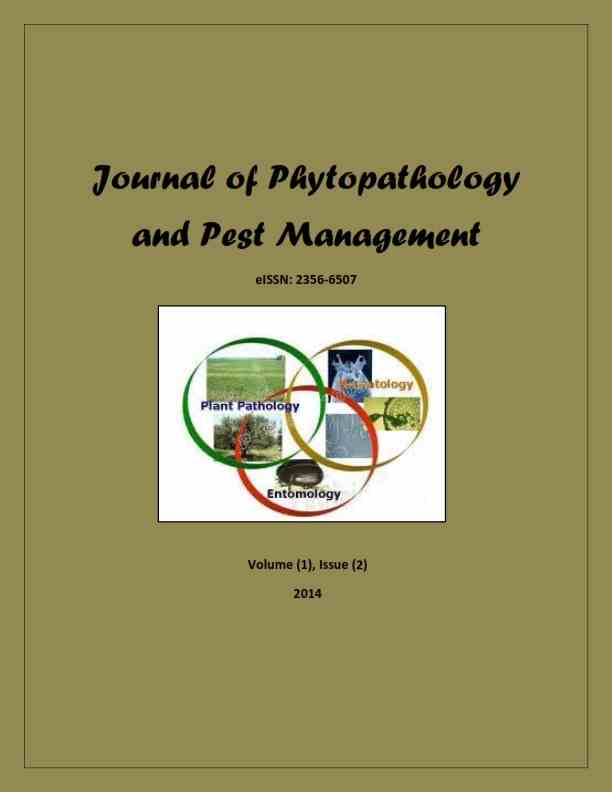Simmondsin as natural alternative fungicide in squash root rot disease
Keywords:
Simmondsin, antifungal, plant extract, squash, root rot, Fusarium solani and Rhizoctonia solaniAbstract
Jojoba (Simmondsia chinensis) meal was extracted with acetone, isopropanol, boiling distilled water and methanol to obtain simmondsin. Simmondsin was tested against Squash root rot disease at four concentrations (10, 20, 30 and 40 mg/ml) using the radial mycelia growth under greenhouse and field conditions. Rhizoctonia solani (Kuhn) and Fusarium solani (Mart.) were isolated from naturally infected squash roots collected from different localities in Qalubia Governorate. Evaluation simmondsin extracts revealed that acetone was the most effective as it prevented the myceial growth of F. solani and R. solani at 40 mg/ml, followed by isopropanol, boiling water and methanol in vitro. All extracts even at concentration 10 mg/ml had little effect and failed to produce a considerable reduction in growth of the tested fungi. Squash Eskandrany seeds were treated with simmondsin extracts before sowing in artificially infested soil with F. solani and R. solani (pot experiments) or soil naturally infected (epidemic soil) by the tested pathogenic fungi (field experiments) resulted in significant reduction in both damping- off and dead plant (resulted from infection by root-rot disease) compared with untreated seeds. Also, both acetone and isopropanol extract were more efficient in reducing infection by damping-off and root-rot than boiling distilled water and methanol. While, squash seeds treated with tested simmondsin extract significantly increased fruit yield/plot compared with untreated seeds. Also, all tested simmondsin extracts significant increased plant survival.
Squash eskandrany seeds were treated with simmondsin extracts before sowing in artificially infested soil with F. solani and R. solani (pot experiments) or soil naturally infected (epidemic soil) by tested pathogenic fungi (field experience) resulted insignificant reduction in both damping- off and dead plant (resulted from infection by root-rot disease) compared with untreated seeds. Also, both Acetone and Isopropanol were more efficient reducing infection by damping-off and root-rot the high concentration 40 mg/ml than Boiling water and Methanol. On the other hand, squash seeds treated with tested simmondsin extract significantly increased fruit yield/plot compared with untreated seeds. Also, all tested simmondsin extracts significant increased plant survival.
Metrics

Downloads
Published
How to Cite
Issue
Section
License
Authors who publish with Journal of Phytopathology and Disease Management agree to the following terms:
- Authors retain copyright and grant the journal right of first publication with the work simultaneously licensed under a Creative Commons Attribution License that allows others to share the work with an acknowledgement of the work's authorship and initial publication in this journal.
- Authors retain copyright and grant the journal right of first publication with the work simultaneously licensed under the Creative Commons Attribution-Non Commercial License (CC BY-NC). This allows others to share the work with an acknowledgement of the work's authorship and initial publication in this journal.
- Archives of Agricultural Sciences Journal is an Open Access Journal, and articles published are distributed under the terms of the Creative Commons Attribution-Non Commercial License (CC BY-NC). Readers may copy, distribute, and display the work for non commercial purposes with the proper citation of the original work. However, the journal retains the right to exploit subsidiary rights on behalf of the authors.
- Authors are able to enter into separate, additional contractural arrangements for the non-exclusive distribution of the journal's published version of the work (e.g. post it to an institutional repository or publish it in a book), with an acknowledgement of its initial publication in this journal.
- Authors are permitted and encouraged to post their work online (e.g., in institutional repositories or on their website) prior to and during the submission process with full disclosure to the journal, as it can lead to productive exchanges, as well as earlier and greater citation of published work. Following publication in Archives of Agricultural Sciences Journal, the author should update the repository, and include a citation and link to the published work.
Click here for more information on Licensing policy
.png)




